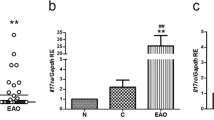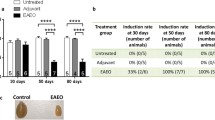Abstract
We previously established an experimental model of autoimmune orchitis (EAO) by means of immunization with testicular germ cells (TGC) alone in mice and confirmed that the disease can be transferred to mice that had received CD4+ but not CD8+ or B lymphocytes obtained from TGC-immunized donor mice. The tubuli recti (TR) are special in that lymphocytes first accumulate around them before spreading to the peripheral seminiferous tubules in EAO. However, the minute changes in the TR remain unknown. Therefore, we investigated the histopathology of the TR before the induction of spermatogenic disturbance. The results revealed that the first infiltrating lymphocytes around the TR were not only of T-cell but also of B-cell lineage. Moreover, it was also shown that some of these infiltrating lymphocytes migrated into the TR, with resultant degeneration of the TR epithelium before damage to the seminiferous epithelium. These findings indicate that TR epithelial cells are the first targets of autoreactive T and B lymphocytes in EAO.
Similar content being viewed by others
References
Schuppe HC, Meinhardt A, Allam JP, Bergmann M, Weidner W, Haidl G (2008) Chronic orchitis: a neglected cause of male infertility? Andrologia 40:84–91
Theas MS, Rival C, Jarazo-Dietrich S, Jacobo P, Guazzone VA, Lustig L (2008) Tumour necrosis factor-alpha released by testicular macrophages induces apoptosis of germ cells in autoimmune orchitis. Hum Reprod 23:1865–1872
Suominen J, Söderström KO (1982) Lymphocyte infiltration in human testicular biopsies. Int J Androl 5:461–466
Aitchison M, Mufti GR, Farrell J, Paterson PJ, Scott R (1990) Granulomatous orchitis. Review of 15 cases. Br J Urol 66:312–314
Itoh M, Hiramine C, Hojo K (1991) A new murine model of autoimmune orchitis induced by immunization with viable syngeneic testicular germ cells alone. I. Immunological and histological studies. Clin Exp Immunol 83:137–142
Tokunaga Y, Terayama H, Naito, M, Qu N, Hirai S, Ogawa Y, Yi SQ, Itoh M (2008) Splenic cytokines in mice immunized with testicular germ cells. Int J Androl 31:471–476
Itoh M, Mukasa A, Tokunaga Y, Hiramine C, Hojo K (1991) New experimental model for adoptive transfer of murine autoimmune orchitis. Andrologia 23:415–420
Itoh M, De-Rooij D, Takeuchi Y (1995) Mode of inflammatory cell infiltration in testes of mice injected with syngeneic testicular germ cells without adjuvant. J Anat 187:671–679
Tung KS, Yule TD, Mahi-Brown CA, Listrom MB (1987) Distribution of histopathology and Ia positive cells in actively induced and passively transferred experimental autoimmune orchitis. J Immunol 138:752–759
Dym M (1976) The mammalian rete testis: a morphological examination. Anat Rec 186:493–523
Dym M, Romrell LJ (1975) Intraepithelial lymphocytes in the male reproductive tract of rats and rhesus monkeys. J Reprod Fertil 42:1–7
Hees H, Wrobel KH, Kohler T, Abou-Elmagd A, Hees I (1989) The mediastinum of the bovine testis. Cell Tissue Res 255:29–39
Yakirevich E, Yanai O, Sova Y, Sabo E, Stein A, Hiss J, Resnick MB (2002) Cytotoxic phenotype of intra-epithelial lymphocytes in normal and cryptorchid human testicular excurrent ducts. Hum Reprod 17:275–283
Naito M, Terayama H, Hirai S, Qu N, Moriyama H, Itoh M (2008) The presence of intra-tubular lymphocytes in normal testis of the mouse. Okajimas Folia Anat Jpn 85:91–96
Itoh M, Hiramine C, Mukasa A, Tokunaga Y, Fukui Y, Takeuchi Y, Hojo K (1992) Establishment of an experimental model of autoimmune epididymo-orchitis induced by the transfer of a T-cell line in mice. Int J Androl 15:170–181
Itoh M, Hiramine C, Tokunaga Y, Mukasa A, Hojo K (1991) A new murine model of autoimmune orchitis induced by immunization with viable syngeneic testicular germ cells alone. II. Immunohistochemical findings of fully-developed inflammatory lesion. Autoimmunity 10:89–97
Hiramine C, Hojo K (1984) Requirement of B lymphocytes in local adoptive transfer of experimental allergic orchitis (EAO) by lymph node cells. Am J Reprod Immunol 196:85–91
Itoh M, Hiramine C, Mukasa A, Tokunaga Y, Fukui Y, Takeuchi Y, Hojo K (1993) Antigen non-specific tissue damage in T cell-mediated experimental autoimmune orchitis: preliminary characterization of a testis-specific T-cell line by using dermal tissue and cells. Andrologia 25:89–92
Boockfor FR, Schwarz LK (1991) Effects of interleukin-6, interleukin-2, and tumor necrosis factor alpha on transferrin release from Sertoli cells in culture. Endocrinology 129:256–262
Yule TD, Tung KS (1993) Experimental autoimmune orchitis induced by testis and sperm antigen-specific T cell clones: an important pathogenic cytokine is tumor necrosis factor. Endocrinology 133:1098–1107
Itoh M, Yano A, Xie Q, Iwahashi K, Takeuchi Y, Meroni PL, Nicoletti F (1998) Essential pathogenic role for endogenous interferon-gamma (IFN-gamma) during disease onset phase of murine experimental autoimmune orchitis. I. In vivo studies. Clini Exp Immunol 111:513–520
Li L, Itoh M, Ablake M, Macri B, Bendtzen K, Nicoletti F (2002) Prevention of murine experimental autoimmune orchitis by recombinant human interleukin-6. Clin Immunol 102:135–137
Kaneko T, Itoh M, Nakamura Y, Iimura A, Hayashi S, Takahashi K, Stivala F, Bendtzen K, Nicoletti F (2003) Proinflammatory effects of exogenously administered IL-10 in experimental autoimmune orchitis. Cytokine 22:50–53
Suescun MO, Rival C, Theas MS, Calandra RS, Lustig L (2003) Involvement of tumor necrosis factor-alpha in the pathogenesis of autoimmune orchitis in rats. Biol Reprod 68:2114–2121
Lysiak JJ (2004) The role of tumor necrosis factor-alpha and interleukin-1 in the mammalian testis and their involvement in testicular torsion and autoimmune orchitis. Reprod Biol Endocrinol 10:9
Tokunaga Y, Terayama H, Naito M, Qu N, Hirai S, Ogawa Y, Yi SQ, Itoh M (2008) Splenic cytokines in mice immunized with testicular germ cells. Int J Androl 31:471–476
Author information
Authors and Affiliations
Corresponding author
Rights and permissions
About this article
Cite this article
Naito, M., Terayama, H., Hirai, S. et al. Histopathology of the tubuli recti at the start of experimental autoimmune orchitis in mice. Med Mol Morphol 42, 230–235 (2009). https://doi.org/10.1007/s00795-009-0469-4
Received:
Accepted:
Published:
Issue Date:
DOI: https://doi.org/10.1007/s00795-009-0469-4




